Modeling of Biopharmaceutical Processes. Part 2: Process Chromatography Unit Operation
A review of some recent contributions in process chromatography.
ABSTRACT
Process modeling can be a useful tool to aid in process development, process optimization, and process scale-up. When modeling a chromatography process, one must first select the appropriate models that describe the mass transfer and adsorption that occurs within the porous adsorbent. The theoretical understanding of chromatographic behavior can augment available experimental data and aid in the design of specific experiments to develop a more complete understanding of the behavior of a unit operation.
Biotech unit operations, including process chromatography, are complex because of the large number of factors that affect process performance. A typical process chromatography step has 50–100 operating parameters that can impact its performance. In addition, a similar number of raw materials are used during the process step. It is not feasible to evaluate the effect of all of these variables on step performance. The current practice is to use risk analysis to identify process parameters that need to be examined during process characterization with the extent of process modeling limited to use of linear statistical models.1–7
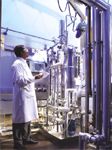
Avecia Biologics Limited
An example of such statistical modeling has been published before in this series.5 The case study involved the design of a process analytical technology-based control scheme for a cation-exchange chromatography step. A design of experiments (DoE) study consisting of 17 experiments was conducted with purity of the load material, start point of pooling (start collect), and end point of pooling (stop collect) as variables. Pool purity and step yield were monitored for each experiment. The results were analyzed using statistical software and are presented in Figure 1. It is seen that load purity and stop collect have a significant impact, where as start collect does not have a significant impact on pool purity. This model was then used to calculate the pool purity for all the experiments that were performed. Figure 2 illustrates a comparison of the pool purities calculated using the statistical model and the actual pool purity as measured by reversed-phase high-performance liquid chromatography (RP HPLC). It is seen that the two numbers correlate very well and support feasibility of this scheme. While this example highlights the usefulness of an empirical model, there are significant limitations of this approach. First, because the model is not based on fundamental principles that govern the unit operation, its predictions are limited to the ranges of data for process parameters that the model is based on, e.g., load impurity of 1.8–5.8% for the case study illustrated in Figure 1. Second, just like any other modeling approach, the underlying assumptions have to hold true for the model to be accurate.

Anurag Rathore
If possible, it is always preferable to create a process model based on fundamental principles. Such a process model can be used as a tool for optimization, scale-up, and manufacturing support. This article is the thirteenth in the Elements of Biopharmaceutical Production series and focuses on process modeling tools that can be useful in capturing the process understanding. We review some of the significant and recent contributions in the area of process modeling of process chromatography along with examples from existing biotech processes.1–5

Figure 1.Statistical analysis of data from chromatography experiments
CONSIDERATIONS FOR MODELING PROCESS CHROMATOGRAPHY
When modeling chromatographic separation processes, the model used to describe mass transport within the column must first be selected. Models used to describe the separation process are well established in the literature and are based on fundamental thermodynamic and mass-transfer relationships.8 A schematic of the separation process that occurs within the chromatography column during protein adsorption is shown in Figure 3. During the adsorption process, protein is first transported from the bulk-liquid phase to the surface of the porous adsorbent, at which point it diffuses into the porous structure and is adsorbed to the surface by electrostatic or hydrophobic interactions. The mode of adsorption is dependent on the type of chromatography ligand chosen for the adsorption process, such as affinity, ion exchange, or hydrophobic interaction. Model input parameters include the process operating conditions (feed concentration and operating velocity), properties of the packed bed (bed porosity, bed height, and HETP) and the protein-adsorbent equilibrium isotherm relationship. A material balance is used to relate the protein present in the liquid phase of the column to that adsorbed inside the porous adsorbent and predict the protein concentration in the column outlet.
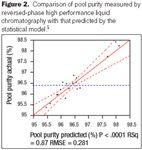
Figure 2. Comparison of pool purity measured by reversed-phase high performance liquid chromatography with that predicted by the statistical model
The adsorption and separation processes in a column are complex, and vary with both column position and time. Protein mass transport in the column is governed by two resistances: transport of protein from the bulk fluid to the surface of the adsorbent (called film mass transfer) and transport of protein within the porous adsorbent (called intraparticle mass transfer). Intraparticle mass transfer is composed of: protein diffusion into the adsorbent and protein binding to the adsorbent surface (surface reaction). Several assumptions are routinely made to simplify the models used to describe mass transport in the column. First, columns are assumed to be radially homogenous, and therefore, properties vary only with the column bed height but not with the column radius. Second, for porous adsorbents, intraparticle mass transfer is governed by protein diffusion, as protein adsorption to the stationary phase (surface reaction) occurs much more rapidly and does not contribute significantly to mass transport. The adsorption process is assumed to occur instantaneously, with equilibrium between the protein adsorbed to the stationary phase and that present in the liquid solution.
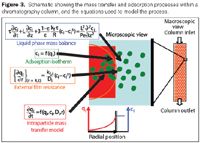
Figure 3. Schematic showing the mass transfer and adsorption processes within a chromatography column, and the equations used to model the process
The adsorption equilibrium data, also known as the adsorption isotherm, are used to relate the protein concentration in the liquid phase inside the column to that adsorbed to the surface of the adsorbent over a range of concentrations. Data for the adsorption isotherm are usually generated in separate experiments under equilibrium conditions. A variety of models can be used to describe the equilibrium adsorption isotherm, with the two most common being the Langmuir and Steric-Mass Action (SMA) models.9–10 Correlations for several of the other column model parameters, including the film mass-transfer coefficient and axial dispersion, are used to estimate values under the process operating conditions evaluated in the separation.

Table 1. Models used to describe intraparticle mass transfer (governed by diffusion) and adsorption equilibrium used to model chromatography separations
Models are also required to describe intraparticle protein diffusion and are shown in Table 1. Two of the most commonly used models include the homogenous (surface) diffusion and the pore diffusion model. These two models assume different physical mechanisms for the diffusion of proteins into the porous stationary adsorbents. The homogeneous diffusion model assumes that the protein adsorbed to the stationary phase is free to migrate, or diffuse, along the solid surface. The driving force for the homogeneous diffusion model is the protein concentration gradient in the adsorbed phase. On the other hand in the pore diffusion model, it is assumed that intraparticle mass transfer occurs by diffusion in liquid-filled pores with a driving force expressed in terms of the radial pore fluid concentration gradient. The adsorbed protein is assumed to be in equilibrium with that in the pore fluid at each radial position in the particle.

Table 2. Experimental and model predictions for the step yield and aggregate levels using a Phenyl Sepharose Fast Flow column. The feed used in the studies consisted of 87% monomer and 13% aggregate.1
MODELING TO ESTIMATE DYNAMIC CAPACITY IN PROCESS CHROMATOGRAPHY
Models describing protein adsorption within a chromatography column can be used to predict the performance of the chromatography step, including the dynamic binding capacity, effects of column scale-up, and separation of complex multicomponent protein mixtures.1,3,11,12 Once the model parameters are known, dynamic binding capacity can be predicted over a range of operating conditions, such as different column bed heights and operating velocities. Because experimental measurement of the dynamic binding in high capacity resins can involve significant amounts of feed material (because protein breakthrough must be achieved), the prediction of the dynamic binding capacity can result in significant savings in development time and protein-feed requirements. Modeling predictions can also be used to determine which adsorbents will have the highest capacities over a range of operating conditions.
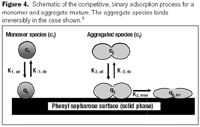
Figure 4. Schematic of the competitive, binary adsorption process for a monomer and aggregate mixture. The aggregate species binds irreversibly in the case shown
McCue, et al., have used modeling to predict the separation of highly complex, multicomponent protein mixtures after adsorption onto the column.1 As a result of recent advancements in computational power, this type of approach can be used to rapidly predict the separation of two or more components possessing similar adsorptive properties, such as the separation of protein and monomer species using hydrophobic interaction chromatography (HIC).1 Table 2 shows an example of model predictions and experimental results for the separation of monomer and aggregate species using Phenyl Sepharose Fast Flow (GE Healthcare) to evaluate product yield and aggregate removal over a range of operating conditions. As with all model formulations, the governing adsorption isotherm model must first be chosen. In the case of the described monomer or aggregate separation, a competitive Langmuir binary adsorption isotherm was selected, in which the aggregate species bound irreversibly to the HIC adsorbent, as shown schematically in Figure 4. When formulating model predictions, a sensitivity analysis should be performed to determine which input parameters have the greatest impact on the model predictions. Once this is known, highly sensitive parameters should be measured as accurately as possible to minimize the uncertainty in the predictions. A model parameter sensitivity analysis can also add further insight into the fundamental mechanisms that govern the particular adsorption or separation. For example, a sensitivity analysis may show the dynamic binding capacity is highly sensitive to moderate changes in the operating velocity. This information could be highly useful for resin selection, as it may be desirable to select a resin in which the performance is insensitive to flow rate, so that the process throughput could be increased without a loss in dynamic binding capacity. A sensitivity analysis could also help in troubleshooting investigations or manufacturing deviations involving chromatography steps. For example, if during the course of an investigation an input parameter was found to be above or below an expected range, the model could be used to predict the effect on column performance, as well as what corrective actions should be taken. Model predictions could be especially useful for troubleshooting if experimental data are not available, as could be the case when unexpected deviations occur in a manufacturing environment.
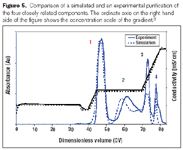
Figure 5. Comparison of a simulated and an experimental purification of the four closely related components. the ordinate axis on the right hand side of the figure shows the concentration scale of the gradient
Mollerup, et al., used a thermodynamic model to simulate elution of several closely related compounds in process chromatography characterized by four key components.3 They assumed that all activity coefficients except the activity coefficients of the solute proteins are unity or constant. In the case of ion-exchange, the data presented demonstrate that the activity coefficients in this case are of minor importance. As seen in Figure 5, the agreement between the adsorption models and the experimental adsorption data is good with respect to the actual chromatogram, impurity profile, yield, and collected fraction volume, thus indicating that the chosen model describes the actual process quite well. Though the conclusions made on the basis of simulation need to be confirmed experimentally, the authors state that proper use of simulations can reduce the number of experiments substantially.
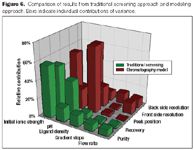
Figure 6. Comparison of results from traditional screening approach and modeling approach. Bars indicate individual contributions of variance.
MODELING TO IDENTIFY OPTIMAL CONDITIONS FOR PROCESS CHROMATOGRAPHY
Kaltenbrunner, et al., recently compared the use of a chromatographic model to rank operational parameters to the traditional statistical experimental design approach.2 They performed both the typical screening of parameters in a fractional factorial experimental design and, independently, developed a theoretical model as described by Yamamoto, et al., for a particular ion-exchange chromatography operation.13 While the original model is based primarily on the response of protein elution to ionic strength, flow rate, and gradient slope; extensions for resin ligand density and pH were included.14 With a series of small-scale linear gradient experiments, a model for the ion-exchange operation based on established response relations was constructed. As interactions and curvature are inherent to the model assumptions, once the right model was chosen, fewer experiments were necessary to define system behavior than with a traditional statistical factorial approach, where no prior information about parameter relations was available. The model was then used to predict a matrix of potential experimental conditions similar to statistical experimental design. In this case though, there were no material restrictions and cost considerations and a full factorial matrix with several factor levels could be modeled easily and rapidly.
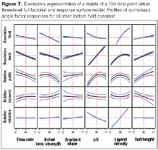
Figure 7. Exemplary representation of a matrix of a 729 data point virtual three-level full factorial and response surface model. Profiles of normalized single factor response for all other factors held constant.
Parameter screening by chromatographic modeling and by fractional factorial experimental design both rank three parameters—the ionic strength at the beginning of the elution gradient, pH, and resin ligand density—as the parameters that have the highest effect on separation behavior (Figure 6). Similarly, both methods identify gradient slope and flow rate—within the range considered in this study—as parameters that have a lesser effect on separation behavior. This comparison indicates that the modeling approach outlined by Yamamoto, et al., can be applied for the initial screening of operational parameters during process characterization. In this case of six model input factors, to obtain a traditional multiple regression model that could describe all possible two-factor interactions and simple quadratic curvature, fewer than 50 factor combinations have to be predicted by the model. To predict all factor combinations for 3 levels, 3 x 3 x 3 x 3 x 3 x 3 = 729 combinations must be calculated. This can easily be done when using computational analysis. As a result, normally neglected higher order interaction could be included in the analysis. Figure 7 represents a virtual full factorial experiment with all combinations of factor inputs at three levels. The panels show changes in predicted recovery and resolution to single factor changes within normalized input ranges from –1 to +1. All other factors were held at center point condition, and therefore, factor interactions were not detectable in this representation. As seen in Figure 8, interactions with pH are demonstrated with respect to two model outputs. The red areas represent factor combinations where the expected product purity is undesirable, and blue areas represent factor combinations where the expected product recovery is undesirable. The model can help inscribe the process design space in which the process performance is acceptable. In practice, the selection of a design space is much more complex than implied in these plots. In these plots, all other parameters were held constant at their target. Although two- or three-dimensional visualization is difficult because of the multidimensional nature of the model, chosen parameter ranges can be tested in all their combinations by stochastic modeling.
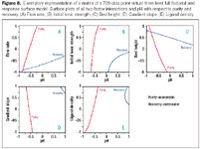
Figure 8. Exemplary representation of a matrix of a 729 data point virtual three-level full factorial and response surface model. Surface plots of all two-factor interactions and pH with respect to purity and recovery.(A)Flow Rate; (B)Initial ionic strength; (c)Bed hight; (D)Gradient Slope; (E) Ligand density
Mollerup, et al., also demonstrated the usefulness of such simulations for process optimization and scale-up.4 As seen in Figure 5, the process model was shown to be in good agreement with the experimental data. This model was then used as a simulation tool to optimize the process. The column size and the properties of the loading solution were fixed and the independent variables that were examined included load volume, flow rate, and gradients. The concentration in the collected pool volume was stipulated to be within specified limits. Figure 9 compares the experimental and the simulated separation. The agreement between the experimental and the simulated chromatogram is satisfactory and sufficient to optimize the current separation. The experimental chromatogram is broader than the simulated one, which indicates that the collected fraction containing the product must be increased compared to that used in the simulation. The results in Table 3 further demonstrate the use of the simulation in optimization and increasing the overall productivity.
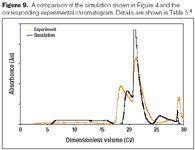
Figure 9. A comparison of the simulation shown in figure 4 and the corresponding experimental chromatogram. Details shown in Table 3
CONCLUSION AND RECOMMENDATIONS
Simulations can be used to identify critical process parameters and support process design and development by making a true optimization with regard to pressure drop, flow rate, gradients, salt, pH, temperature, throughput, yield, purity, and robustness. Applying these modeling tools in the development of chromatographic separations can support the design of effective and efficient manufacturing processes that will consistently ensure a predefined quality at the end of the manufacturing process, consistent with the basic tenet of Quality by Design.
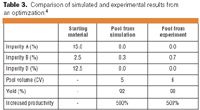
Table 3. Comparison of simulated and experimental results from an optimization.4
REFERENCES:
1. McCue JT, Engel P, Ng A, Macniven R, Thömmes J. Modeling of protein monomer/aggregate purification and separation using hydrophobic interaction chromatography. Bioprocess Biosystems Eng. 2008;31:261–275.
2. Kaltenbrunner O, Giaverini O, Woehle D, Asenjo JA. Application of chromatographic theory for process characterization towards validation of an ion-exchange operation, Biotechnol Bioeng. 2007;98:201–210.
3. Mollerup JM, Hansen TB, Kidal S, Staby A. Quality by Design—Thermodynamic modelling of chromatographic separations of proteins. J Chromatogr A. 2008;1177:200–206.
4. Mollerup JM, Hansen TB, Kidal S, Sejergaard L, Staby A. Development, modeling, optimization and scale-up of chromatographic purification of a therapeutic protein. Fluid Phase Liquid Equilib. 2007;261:133–139.
5. Rathore AS, Sharma A, Chilin D. Applying process analytical technology to biotech unit operations. BioPharm Int. 2006;8:48–57.
6. Seely RJ, Haury J. Applications of failure modes and effects analysis to biotechnology manufacturing processes. In: Rathore AS, Sofer G, editors. Process validation in manufacturing of biopharmaceuticals. Boca Raton: Taylor & Francis; 2005. p. 13–30.
7. Seely, J. Process characterization. Process validation in manufacturing of biopharmaceuticals. Boca Raton: Taylor & Francis; 2005. p. 31–68.
8. Weaver LE, Carta G. Protein adsorption on cation exchangers: comparison of macroporous and gel composite media. Biotechnol Prog. 1996;12:342.
9. Langmuir I. The adsorption of gases on plain surfaces of glass, mica, and platinum. J Am Chem Soc. 1918;40:1361.
10. Brooks CA, Cramer SM. Steric mass-action ion exchange: displacement profiles and induced salt gradients. AIChE Journal. 1992;32:1969.
11. McCue JT, Kemp G, Low D, Quiñones-Garcia. Evaluation of protein-A chromatography media. J. Chromatogr. A. 2003;989:139.
12. Lewus, RK, Carta G, Binary protein adsorption on gel-composite ion-exchange media. AIChE Journal. 1999;45:512.
13. Yamamoto S, Nakanishi K, Matsuno R. Ion-exchange chromatography of proteins. In: J. Cazes, editor. Chromatographic Science Series. New York: Marcel Dekker; 1988. vol. 43.
14. Watler P, Yamamoto S, Kaltenbrunner O, Feng D. Engineering aspects of ion-exchange chromatography. In: Rathore AS, Velayudhan A, editors. Scale-up and optimization on preparative chromatography. New York: Marcel Dekker, Inc.; 2003.
Oliver Kaltenbrunner is a principal scientist at Amgen, Inc., Thousand Oaks, CA. Justin McCue is a senior engineer and Philip Engel is a scientist of process development at Biogen Idec Corporation, Cambridge, MA. Jorgen M. Mollerup teaches at Department of Chemical and Biochemical Engineering, Technical University of Denmark, Lyngby, Denmark. Anurag S. Rathore, PhD, is a director of process development at Amgen, Inc., Thousand Oaks, CA, 805.447.4491, arathore@amgen.com He is also a member of BioPharm International's Editorial Advisory Board.
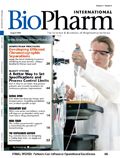
VERAXA and Voyager to Create Combined Business for Advancing Pipeline of Next-Gen Cancer Therapies
April 23rd 2025The proposed business combination would create a publicly traded, clinical-stage biopharmaceutical company that will focus on developing a pipeline of next-generation cancer therapies.
Tokyo University of Science Research Team Explores Improved Delivery of Antisense Oligonucleotides
April 18th 2025Using cholesterol-modified oligonucleotides, the research team aims to improve the delivery of antisense nucleotide-based therapies for treating neurodegenerative diseases and brain cancers.
Thermo Fisher Opens Advanced Therapies Collaboration Center in California
April 18th 2025The 6000-square-foot facility will provide cell therapy developers the support they need to transition to CGMP manufacturing, and an expanded footprint of the new center is expected to open in Philadelphia later in 2025.